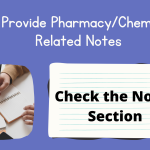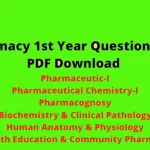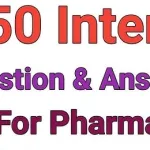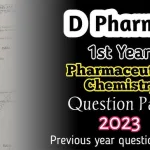Pharmacy is a field of study that involves the preparation and dispensing of medications. In the first year of D Pharmacy, students are introduced to various subjects that form the foundation of their pharmaceutical knowledge.
D Pharmaceutics 2018 – Questions and Answers
Question: What is the primary objective of dosage form design?
Answer: The primary objective of dosage form design is to ensure the proper delivery of drugs to the site of action in a safe and effective manner.
Question: Define bioavailability.
Answer: Bioavailability refers to the proportion of a drug that enters the systemic circulation and is available at the site of action.
Question: Explain the term ‘pharmacokinetics’.
Answer: Pharmacokinetics is the study of how a drug is absorbed, distributed, metabolized, and excreted by the body.
Question: What are the types of tablets used in pharmaceuticals?
Answer: Common types of tablets include compressed tablets, sugar-coated tablets, film-coated tablets, and enteric-coated tablets.
Question: Describe the process of granulation.
Answer: Granulation is the process of forming granules by combining powders with binding agents to enhance flowability and compressibility in tablet production.
Question: What is the difference between ointment and cream?
Answer: Ointments are oil-based, thicker, and greasier, while creams are water-based and have a lighter texture.
Question: Name different routes of drug administration.
Answer: Common routes of drug administration include oral, intravenous, intramuscular, subcutaneous, and topical.
Question: What are excipients, and why are they used?
Answer: Excipients are inactive substances used in drug formulations to aid in the manufacturing process and improve drug stability, efficacy, and delivery.
Question: Define first-pass metabolism.
Answer: First-pass metabolism refers to the metabolism of a drug before it reaches the systemic circulation, usually occurring in the liver.
Question: What is the importance of pH in drug formulation?
Answer: pH is important in drug formulation because it affects the solubility and stability of the drug, influencing its absorption and efficacy.
Question: Explain the difference between a solution and a suspension.
Answer: A solution is a homogeneous mixture where the solute is completely dissolved, while a suspension contains undissolved particles dispersed in a liquid.
Question: What is a suppository, and when is it used?
Answer: A suppository is a solid dosage form intended for insertion into the rectum, vagina, or urethra, where it dissolves or melts to exert its effects.
Question: Define the term ‘half-life’ in pharmacokinetics.
Answer: Half-life is the time taken for the concentration of a drug in the bloodstream to reduce by half.
Question: What are sustained-release formulations?
Answer: Sustained-release formulations are designed to release the active ingredient slowly over time, providing prolonged therapeutic effects.
Question: Name a common preservative used in liquid formulations.
Answer: Benzalkonium chloride is a common preservative used in liquid pharmaceutical formulations.
Question: What is the role of a buffer in drug formulations?
Answer: Buffers help to maintain the pH of a drug formulation, ensuring stability and effectiveness.
Question: Describe the term ‘dose-response relationship’.
Answer: The dose-response relationship is the correlation between the dose of a drug and the magnitude of its therapeutic effect.
Question: Explain the importance of isotonicity in injections.
Answer: Isotonicity ensures that injections do not cause irritation or damage to tissues by matching the osmotic pressure of body fluids.
Question: What is the difference between an emulsion and a suspension?
Answer: An emulsion is a mixture of two immiscible liquids, while a suspension is a liquid containing solid particles dispersed within it.
Pharmaceutical Chemistry – Questions and Answers
Question: What is the role of analytical chemistry in pharmacy?
Answer: Analytical chemistry is used to identify, quantify, and purify pharmaceutical compounds, ensuring their safety and efficacy.
Question: Define acid and base according to the Bronsted-Lowry theory.
Answer: According to the Bronsted-Lowry theory, an acid is a proton donor, and a base is a proton acceptor.
Question: What is a buffer solution?
Answer: A buffer solution resists changes in pH when small amounts of an acid or a base are added.
Question: Explain the principle of UV-Visible spectroscopy.
Answer: UV-Visible spectroscopy is based on the absorption of ultraviolet or visible light by molecules, which causes electronic transitions within the molecules.
Question: What is chromatography, and why is it used?
Answer: Chromatography is a technique used to separate and analyze mixtures of compounds based on their interactions with a stationary phase and a mobile phase.
Question: Define ‘enthalpy’.
Answer: Enthalpy is the total heat content of a system, reflecting the energy required to form or break chemical bonds during a reaction.
Question: What is the purpose of a titration in pharmaceutical analysis?
Answer: Titration is used to determine the concentration of a solution by reacting it with a known quantity of a reagent.
Question: Describe the difference between qualitative and quantitative analysis.
Answer: Qualitative analysis identifies the components of a substance, while quantitative analysis measures the amount of each component.
Question: What is a reagent?
Answer: A reagent is a substance used in a chemical reaction to detect, measure, or synthesize other substances.
Question: Explain the term ‘molecular weight’.
Answer: Molecular weight is the sum of the atomic weights of all atoms in a molecule.
Question: What is the principle of IR spectroscopy?
Answer: IR spectroscopy measures the absorption of infrared radiation by molecules, which causes vibrations in chemical bonds, helping to identify functional groups.
Question: What are organic compounds?
Answer: Organic compounds are chemical compounds that contain carbon, typically bonded to hydrogen, oxygen, nitrogen, or other elements.
Question: Define oxidation and reduction reactions.
Answer: Oxidation is the loss of electrons, while reduction is the gain of electrons during a chemical reaction.
Question: What is a functional group in organic chemistry?
Answer: A functional group is a specific group of atoms within a molecule that determines its chemical behavior.
Question: Name a common solvent used in pharmaceutical synthesis.
Answer: Ethanol is a common solvent used in pharmaceutical synthesis.
Question: What is a catalyst, and how does it work?
Answer: A catalyst is a substance that increases the rate of a chemical reaction without being consumed by lowering the activation energy.
Question: Explain the importance of pH in pharmaceutical chemistry.
Answer: pH affects the solubility, stability, and reactivity of drugs, making it critical in drug formulation and analysis.
Question: What are enantiomers?
Answer: Enantiomers are a pair of molecules that are mirror images of each other and have different effects in biological systems.
Question: Define ‘stereochemistry’.
Answer: Stereochemistry is the study of the spatial arrangement of atoms within molecules and how this affects their chemical behavior.
Question: What is an electrolyte?
Answer: An electrolyte is a substance that conducts electricity when dissolved in water or melted, due to the presence of ions.
Pharmacology – Questions and Answers
Question: What is pharmacology?
Answer: Pharmacology is the study of drugs and their effects on living organisms.
Question: Define the term ‘agonist’.
Answer: An agonist is a substance that binds to a receptor and activates it, producing a biological response.
Question: What is a receptor?
Answer: A receptor is a protein on the surface of or inside a cell that binds to specific molecules, triggering a biological effect.
Question: Explain the difference between a competitive and non-competitive inhibitor.
Answer: A competitive inhibitor binds to the active site of a receptor, blocking the agonist, while a non-competitive inhibitor binds to a different site, altering the receptor’s function.
Question: What is the therapeutic index of a drug?
Answer: The therapeutic index is the ratio of a drug’s toxic dose to its effective dose, indicating its safety margin.
Question: Define adverse drug reaction (ADR).
Answer: An adverse drug reaction is an unwanted or harmful effect experienced after the administration of a drug under normal conditions.
Question: What are antipyretic drugs?
Answer: Antipyretic drugs are medications used to reduce fever.
Question: What is drug tolerance?
Answer: Drug tolerance occurs when a person requires a higher dose of a drug to achieve the same therapeutic effect due to repeated use.
Question: Explain the term ‘pharmacodynamics’.
Answer: Pharmacodynamics is the study of the biochemical and physiological effects of drugs and their mechanisms of action.
Question: What is an antagonist?
Answer: An antagonist is a substance that binds to a receptor but does not activate it, thus blocking the action of an agonist.
Question: Define bioequivalence.
Answer: Bioequivalence refers to the comparison between two pharmaceutical products, showing they have similar bioavailability and therapeutic effects.
Question: What is pharmacovigilance?
Answer: Pharmacovigilance is the process of monitoring and assessing the safety of drugs after they have been released on the market.
Question: Explain the term ‘first-pass effect’.
Answer: The first-pass effect is the process by which a drug is metabolized in the liver before it reaches systemic circulation, reducing its bioavailability.
Question: What are anticholinergic drugs?
Answer: Anticholinergic drugs are substances that block the action of acetylcholine, a neurotransmitter involved in the transmission of nerve impulses.
Question: Define therapeutic window.
Answer: The therapeutic window is the range of drug concentrations in the blood between the minimum effective concentration and the toxic concentration.
Question: What is drug metabolism?
Answer: Drug metabolism is the chemical alteration of a drug in the body, usually carried out by enzymes in the liver.
Question: Explain the difference between systemic and local drug action.
Answer: Systemic drug action occurs throughout the body after the drug enters the bloodstream, whereas local drug action is restricted to the site of application.
Question: What are prodrugs?
Answer: Prodrugs are inactive compounds that are metabolized in the body to become active drugs.
Question: Define ‘half-life’ in pharmacology.
Answer: In pharmacology, half-life is the time it takes for the concentration of a drug in the bloodstream to decrease by half.
Question: What is drug clearance?
Answer: Drug clearance is the rate at which a drug is removed from the body, typically measured in volume per unit time.
Question: Explain the difference between bactericidal and bacteriostatic antibiotics.
Answer: Bactericidal antibiotics kill bacteria, while bacteriostatic antibiotics inhibit bacterial growth.
Question: What are NSAIDs, and what are they used for?
Answer: Nonsteroidal anti-inflammatory drugs (NSAIDs) are medications used to reduce pain, inflammation, and fever.
Question: What is drug desensitization?
Answer: Drug desensitization refers to a reduced response to a drug after repeated use.
Question: Define the term ‘idiosyncratic reaction’.
Answer: An idiosyncratic reaction is an unusual or abnormal response to a drug that is not related to the dose.
Question: What is the role of cytochrome P450 enzymes in drug metabolism?
Answer: Cytochrome P450 enzymes are responsible for the oxidation of drugs, making them more water-soluble for excretion.
Question: Explain the concept of synergism in pharmacology.
Answer: Synergism occurs when the combined effect of two drugs is greater than the sum of their individual effects.
Question: What are the side effects of opioid drugs?
Answer: Common side effects of opioid drugs include drowsiness, constipation, nausea, and respiratory depression.
Question: What is the difference between acute and chronic toxicity?
Answer: Acute toxicity occurs after a single exposure to a toxic substance, while chronic toxicity results from repeated exposures over a long period.
Pharmaceutical Chemistry – Questions and Answers
Question: What is a pharmaceutical excipient?
Answer: A pharmaceutical excipient is an inactive substance used in drug formulation to provide stability, bulk, or other characteristics to the dosage form.
Question: Explain the principle of HPLC (High-Performance Liquid Chromatography).
Answer: HPLC separates compounds in a mixture by passing them through a column under high pressure, allowing for the identification and quantification of individual components.
Question: What is a solvent in chemistry?
Answer: A solvent is a liquid in which solutes are dissolved to form a solution.
Question: Define ‘molarity’.
Answer: Molarity is the concentration of a solution, expressed as the number of moles of solute per liter of solution.
Question: What is the significance of the pH scale in pharmaceuticals?
Answer: The pH scale is important in pharmaceuticals because it affects drug stability, solubility, and absorption in the body.
Question: What is a chelating agent?
Answer: A chelating agent is a compound that forms complexes with metal ions, preventing them from participating in chemical reactions.
Question: Describe the process of crystallization.
Answer: Crystallization is the process of forming solid crystals from a solution or melt, often used to purify substances in pharmaceutical production.
Question: Explain the difference between a covalent bond and an ionic bond.
Answer: A covalent bond involves the sharing of electrons between atoms, while an ionic bond involves the transfer of electrons from one atom to another.
Question: What is the role of catalysts in chemical reactions?
Answer: Catalysts speed up chemical reactions by lowering the activation energy without being consumed in the process.
Question: Define ‘isomerism’.
Answer: Isomerism occurs when two or more compounds have the same molecular formula but different structures, resulting in different chemical properties.
Question: What is the significance of stereochemistry in pharmaceuticals?
Answer: Stereochemistry is important in pharmaceuticals because the 3D arrangement of atoms in a drug molecule can affect its biological activity and interaction with receptors.
Question: Explain the difference between a primary and secondary amine.
Answer: A primary amine has one alkyl or aryl group attached to the nitrogen atom, while a secondary amine has two such groups.
Question: What is the purpose of a titration in pharmaceutical analysis?
Answer: Titration is used to determine the concentration of a solution by adding a reagent of known concentration until a reaction is complete.
Question: Define the term ‘electrophile’.
Answer: An electrophile is a species that accepts an electron pair during a chemical reaction, often reacting with nucleophiles.
Question: What is the importance of molecular weight in drug formulation?
Answer: Molecular weight affects the pharmacokinetics and pharmacodynamics of a drug, influencing its absorption, distribution, metabolism, and excretion.
Question: Describe the difference between polar and non-polar molecules.
Answer: Polar molecules have an uneven distribution of electron density, leading to partial charges, while non-polar molecules have an even distribution of electrons.
Question: What is an oxidation-reduction (redox) reaction?
Answer: A redox reaction is a chemical reaction in which electrons are transferred between molecules, involving oxidation (loss of electrons) and reduction (gain of electrons).
Question: Explain the concept of the ‘activation energy’ in a chemical reaction.
Answer: Activation energy is the minimum energy required for a chemical reaction to occur, allowing reactants to reach the transition state.
Question: What is a free radical in chemistry?
Answer: A free radical is a highly reactive molecule with an unpaired electron, often involved in oxidation reactions.
Question: Define the term ‘nucleophile’.
Answer: A nucleophile is a species that donates an electron pair to form a chemical bond, typically reacting with electrophiles.
Pharmaceutics – Questions and Answers
Question: What is the role of preservatives in pharmaceutical formulations?
Answer: Preservatives prevent microbial growth and contamination in pharmaceutical formulations, ensuring the safety and stability of the product.
Question: Define the term ‘bioavailability’.
Answer: Bioavailability refers to the proportion of a drug that reaches the systemic circulation and is available at the site of action.
Question: What is a sustained-release dosage form?
Answer: A sustained-release dosage form releases the active ingredient slowly over time, providing prolonged therapeutic effects.
Question: Describe the process of emulsification.
Answer: Emulsification is the process of mixing two immiscible liquids (e.g., oil and water) to form a stable emulsion, often used in creams and lotions.
Question: What is the importance of isotonicity in injections?
Answer: Isotonicity ensures that injections do not cause irritation or damage to tissues by matching the osmotic pressure of body fluids.
Question: What is the difference between ointments and creams?
Answer: Ointments are thicker and greasier, used for occlusive effects, while creams are lighter and water-based, suitable for non-greasy applications.
Question: Define ‘granulation’ in tablet production.
Answer: Granulation is the process of forming granules by combining powders with a binding agent, improving flowability and compressibility for tablet production.
Question: What is a transdermal patch?
Answer: A transdermal patch is a medicated adhesive patch applied to the skin, allowing drugs to be absorbed directly into the bloodstream.
Question: Explain the difference between enteric-coated and film-coated tablets.
Answer: Enteric-coated tablets have a coating that prevents dissolution in the stomach, while film-coated tablets have a thin protective layer to improve stability and appearance.
Question: What is the significance of drug solubility in formulation?
Answer: Drug solubility affects the rate and extent of drug absorption, influencing its bioavailability and therapeutic efficacy.
Question: Define the term ‘suppository’.
Answer: A suppository is a solid dosage form designed for insertion into the rectum, vagina, or urethra, where it dissolves or melts to exert its effects.
Question: What is the purpose of coating tablets?
Answer: Tablet coating improves the appearance, taste, and stability of the tablet, and can also control the release of the drug.
Question: What is meant by the term ‘sterilization’?
Answer: Sterilization is the process of eliminating all forms of microbial life from pharmaceutical products to ensure their safety and effectiveness.
Question: Explain the importance of dissolution testing.
Answer: Dissolution testing measures the rate at which a drug is released from its dosage form, ensuring consistent bioavailability and therapeutic effects.
Question: What is the difference between a solution and a suspension?
Answer: A solution is a homogeneous mixture where the solute is completely dissolved, while a suspension contains undissolved solid particles dispersed in a liquid.
Question: Define ‘osmotic pressure’.
Answer: Osmotic pressure is the pressure exerted by a solution when water moves across a semi-permeable membrane, important in maintaining isotonicity in pharmaceutical formulations.
Question: What is the function of a binder in tablet formulation?
Answer: A binder helps to hold the ingredients of a tablet together, improving its mechanical strength and cohesiveness.
Ending Paragraph
Pharmacy is a complex and essential field that plays a vital role in healthcare. By mastering the fundamental concepts in D Pharmacy 1st year, students can build a strong foundation for their future studies and careers. These questions and answers aim to provide clear and concise information to help students prepare effectively for their exams.
Meta Title
Meta Description
Latest Posts
- Step-by-step guide to download and apply for jee mains admit card 202
- Comprehensive 2025 government holidays and recruitment details for job seekers
- JEE Mains Admit Card 2025: Your Step-by-Step Guide to Downloading the Hall Ticket
- Everything You Need to Know About 2025 Government Holidays Recruitment
- Comprehensive Guide to rrb d group recruitment 2025 – Eligibility, Vacancies, and Application
- Detailed guide to nps trust recruitment 2025 vacancies, eligibility and apply process
- Comprehensive guide to hpcl recruitment 2025 notification, vacancies, and application process
- ignou bed admission 2025 complete recruitment guide with eligibility and process
- Comprehensive Guide to Indian Army Agniveer Recruitment 2025 Notification and Jobs
- Everything You Must Know About CBSE Board Exams 2025 Changes & New Rules






